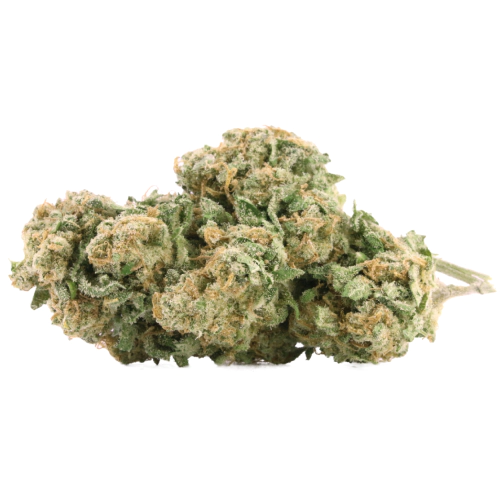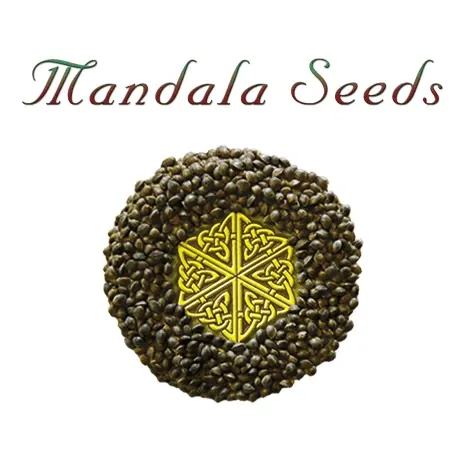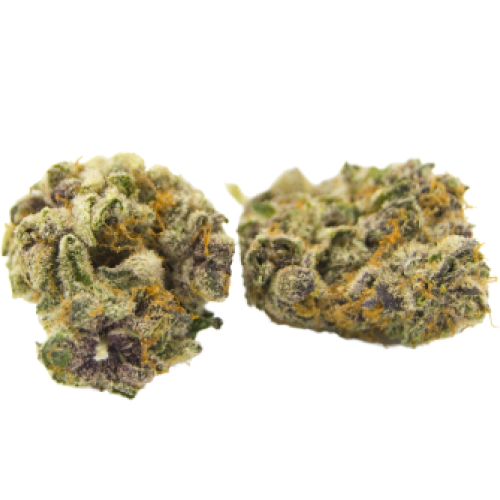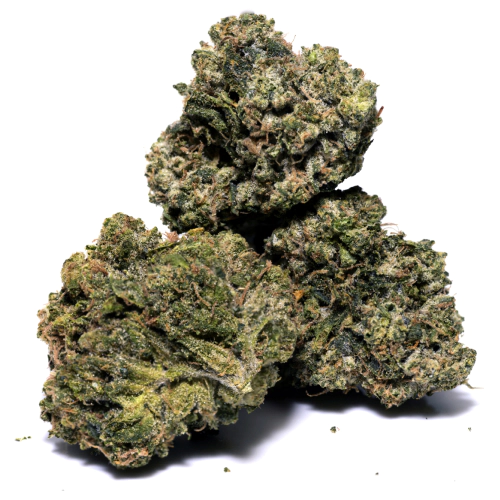
THC 15.5 - 17.67%
CBD 0.42 - 0.71%
Effect Sleepy
Flavor Spicyherbal
12 - 13.6%
0.78 - 1.08%
0.06 - 0.6%
Berry, Sweet
Sleepy
The Strain of the Year by High Times in 2006, Hashberry is a mostly Indica hybrid with an obscure origin. It is only known that this weed takes its roots from North India. The THC ratio has been measured at 15-18%. This strain is recommended for nighttime usage.
Hashberry strain has a memorable classic Indica-dominant hybrid aroma and taste. Its taste has a blend of sweet blackcurrant with hashish notes and minty aftertaste on the exhale. Its aroma has been described as minty, peppery, and berry.
The onset of Hashberry strain's high is reported as Sativa-like and delivers cerebral activity, stimulates creativity, and increases focus. It calms the mind leaving the head clean and elevating mood. However, as the high settled in, the Indica-leaning effect comes in. The second stage is said to induce sleepiness and full-body relaxation. Some users have reported a boost of euphoria and hunger.
Hashberry weed strain carries benefits for medical cannabis consumers. It alleviates symptoms of anxiety, stress, and depression. Its sedative effect surely helps to treat insomnia as well as an appetite-stimulating effect is useful to combat eating disorders. It can ease physical ailments such as chronic pain and aches.
Hashberry seeds are available at online stores and can be purchased with ease. Its medium in height plants are well suited for beginners as do not require much attention. In outdoor gardens, it is ready to be harvested in late September - early October. The maturation period takes around 62-72 days.
| THC | Tetrahydrocannabinol, or THC, is a major cannabis chemical compound. It is a psychoactive element that stimulates dopamine release and induces euphoria or happiness. THC-rich strains may be helpful with such conditions as lack of appetite, chronic pains , etc. It is considered to be the primary active marijuana component. | 12 - 13.6% |
| CBD | Cannabidiol, or CBD, is a major compound in cannabis, which is non-psychoactive. It is also proved to counteract the side effects of the second major component THC. CBD is widely used for medicinal purposes in rubs, oils and so on. It is helpful in muscle pain cases, may treat arthritis and migraines. Even Greeks used it against pain, while Queen Victoria applied it to get rid of menstrual cramps. | 0.78 - 1.08% |
| CBC | Cannabichromene, or CBC, is a minor cannabinoid, meaning that its quantity in cannabis is quite little. Though it has the same origin as CBD and THC, it is different in functions. Without any psychoactive effects, it is an efficient cannabis compound in combating acne and depression. CBC produces analgesic, antibacterial and anti-inflammatory effects. | 0.31 - 0.51% |
| CBG | Cannabigerol, or CBG, is one of the minor cannabis compounds in adult plants. On the other hand, young ones contain a lot of this antibacterial and anti-inflammatory component. During the growth, CBG is converted into different cannabinoids, mostly THC and CBD. The compound itself increases appetite and decreases eye pressure. | 0.06 - 0.6% |
| CBN | Cannabinol, or CBN, is a trace element in cannabis that is considered to be mildly psychoactive. It appears from oxidation THC, exposed to light and heat. CBN is mostly contained in old cannabis and in traditional hashish. It is effective against insomnia, bacterial infections and appetite loss. | 0.16 - 0.29% |
| THCV | Tetrahydrocannabivarin, or THC-V, is a compound contained in cannabis in trace amounts. Even though it is close to THC molecularly, it is different in effects. This compound may be psychoactive only in large amounts. THC-V reduces blood sugar, controls appetite, stimulates bone growth, etc. African Sativa strains are the richest in THC-V. | 0.28 - 0.32% |
| Pinene | Pinene is one of the most widespread terpenes in nature, found in pine trees, basil, nutmeg, parsley, and rosemary. Cannabis containing terpene (alpha-pinene or α-pinene) boasts a strong pine scent. Pinene is responsible for anti-inflammatory, pain-relieving, and anti-anxiety effects. | 0.05% |
| Myrcene | Myrcene (also known as β-myrcene) is one of the most common terpenes found in cannabis, representing more than 20% of the modern marijuana terpene profile. Myrcene has a distinct earthy, musky flavor, resembling cloves. It is responsible for calming and soothing effects of weed. Myrcene is also found in hops, thyme, mango, lemongrass, guava melon. | 0.41% |
| Ocimene | Ocimene (derived from the Ancient Greek word Ocimum meaning basil) is a terpene with sweet and herbaceous flavors, also boasting citrusy and woody undertones. Naturally, ocimene occurs in mint, parsley, orchids, hops, kumquats, mangoes, basil, bergamot, lavender, and pepper. Offers antifungal, anti-inflammatory, and antiviral properties. | 0.07% |
| Humulene | Humulene (also known as α-humulene) is one of the major terpenes found in cannabis, contributing to woody, earthy, spicy, herbaceous, and, mainly, floral aromas of cannabis. Used in modern medicine, humulene offers anti-inflammatory, antibacterial, and appetite suppressant effects, which have been well-researched by pharmaceutical companies. | 0.21% |
| Limonene | Limonene (also known as d-limonene) is the second most common terpene in nature and the third most common terpene in cannabis. It has a powerful citrus aroma and can be found in all citruses, including lemons, oranges, grapefruits, limes, juniper, etc. Limonene is known to elevate moods and provide anxiety, depression, and stress relief. | 0.13% |
| Linalool | Linalool (also known as beta linalool, linalyl alcohol, linaloyl oxide, and p-linalool) is one of the rarest terpenes found in cannabis, mostly in small quantities. Linalool is known for its spicy and lavender aroma, bringing relaxation and calming effects. It is also said to provide anti-inflammatory and analgesic properties that can be useful for athletes. | 0.01% |
| Terpinolene | Terpinolene is one of the most common terpenes found in cannabis; however, It's usually presented in small quantities. Is responsible for piney, floral, herbaceous, and even a little bit citrusy aroma of cannabis. Terpinolene can be found in lilacs, nutmeg, and cumin. In cannabis, terpinolene contributes to the sensation of "freshness." Has the potential to reduce the risk of heart diseases. | 0.03% |
| Caryophyllene | Caryophyllene (also known as beta or b caryophyllene) is a terpene found in many herbs and spices, such as black pepper, basil, rosemary, and oregano. Cannabis high in caryophyllene delivers a strong spicy, peppery aroma, resembling cinnamon and cloves. Caryophyllene offers potent anti-inflammatory and sedative effects. | 0.09% |
| Total terpenes content | 1.00% |


THC 15.5 - 17.67%
CBD 0.42 - 0.71%
Effect Sleepy
Flavor Spicyherbal
THC 18.8 - 20.2%
CBD 0.23 - 0.38%
Effect Relaxed
Flavor Sweet
THC 17 - 17.5%
CBD 0.35 - 0.6%
Effect Giggly
Flavor Spicyherbal

THC 23.5 - 26%
CBD 0.66 - 0.88%
Effect Happy
Flavor Spicyherbal
THC 17.75 - 19.5%
CBD 0.3 - 0.43%
Effect Uplifted
Flavor Sweet
THC 16.5 - 18.75%
CBD 0.53 - 0.74%
Effect Relaxed
Flavor Sweet

THC 16.25 - 19.5%
CBD 2.39 - 2.7%
Effect Relaxed
Flavor Berry
THC 17 - 20%
CBD 0.44 - 1.35%
Effect Tingly
Flavor Honey
THC 11.5 - 16.5%
CBD 6 - 15%
Effect Aroused
Flavor Pear

THC 21 - 23%
CBD 0.4 - 0.63%
Effect Tingly
Flavor Woody
THC 16.75 - 21.5%
CBD 0.7 - 1.27%
Effect Sleepy
Flavor Apricot
THC 19 - 19%
CBD 0.2 - 0.49%
Effect Relaxed
Flavor Lime
THC 15.5 - 22%
CBD 0.02 - 0.19%
Effect Uplifted
Flavor Pear
Be the first and share your opinion
Write a Review